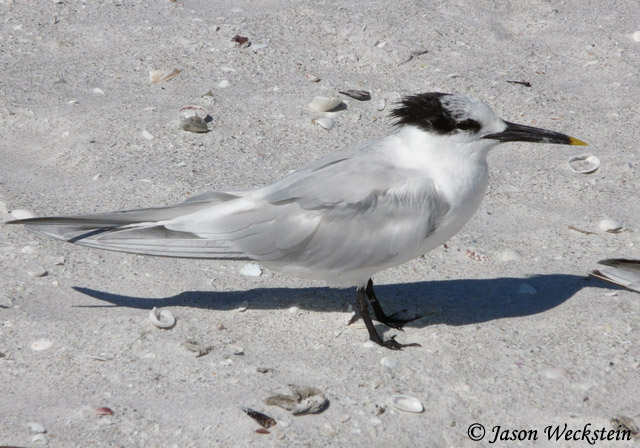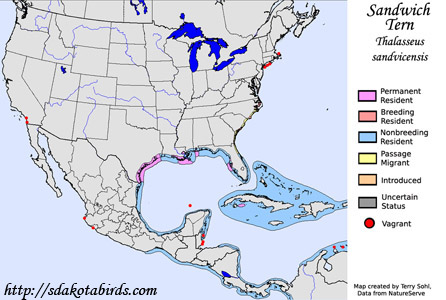| Length: 15 inches | Wingspan: 34 inches | Seasonality: Non-resident in South Dakota |
| ID Keys: Black bill with light tip, full dark cap in breeding plumage, rear cap in non-breeding, light gray wings, white underparts | ||
 The
Sandwich Tern is found in many parts of the world, breeding in select
locations in Europe, southwestern Asia, Africa, South America, and the
Caribbean. In North America, they are only found along the Gulf Coast
of Mexico and the United States, and along the Atlantic coast of the U.S.
during the summer months. They are named after the town of Sandwich in
England, the site where the species was first identified.
The
Sandwich Tern is found in many parts of the world, breeding in select
locations in Europe, southwestern Asia, Africa, South America, and the
Caribbean. In North America, they are only found along the Gulf Coast
of Mexico and the United States, and along the Atlantic coast of the U.S.
during the summer months. They are named after the town of Sandwich in
England, the site where the species was first identified.
Habitat: Found in areas with sandy areas during the nesting season, such as sandy islands or beaches. Outside of the breeding season, Sandwich Terns are found relatively close to shore, in areas with shallow, warm waters.
Diet: Feeds mostly on fish, but will also eat other small invertebrates such as marine worms, squid, and insects.
Behavior: Forages by plunge-diving, typically by flying over the ocean's surface in search of food, hovering when food is spotted, and then plumage-diving.
Nesting: The nest of a Sandwich Tern is a shallow depression on the ground, lined with bits of vegetation or debris. The female usually lays 1 or 2 eggs, and both parents help to incubate them. When the eggs hatch, both parents help to feed them. The young fledge after about 1 month, but typically stay with the parents for a few months after fledging.
Song: The common call of a Sandwich tern is a harsh krrick.
Migration: In North America, birds along the Atlantic Coast move southward for the winter. Some birds are present along the Gulf Coast and in Florida during the winter, but typically at smaller numbers than during the summer months. Some birds may be permanent residents in these regions, but others clearly move south for the winter.
Interactive ebird Map: Click here to access an interactive eBird map of Sandwich Tern sightings
Similar Species: A number of tern species are primarily light colored with a dark cap, and are roughly similar in size, including the Elegant Tern, Royal Tern, Common Tern, Forster's Tern, Roseate Tern.
Conservation Status: Populations are considered stable, they are found over a very wide geographic area, and they are common in parts of their range. The IUCN lists the Sandwich Tern as a species of "Least Concern".
Further Information: 1) Florida Fish and Wildlife Conservation Commission - Sandwich Tern
2) BirdLife International - Sandwich Tern
3) Audubon Guide - Sandwich Tern
Photo Information: Photo taken by Jason Weckstein - February 10th, 2007 - Sanibel, Florida - Photo licensed under Creative Commons Attribution NonCommercial ShareAlike 2.0 Generic License.
| Click below for a higher-resolution map |
 |
| South Dakota Status: Non-resident in South Dakota |
Additional Sandwich Tern Photos (coming soon!!)
